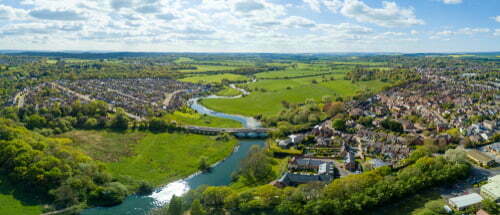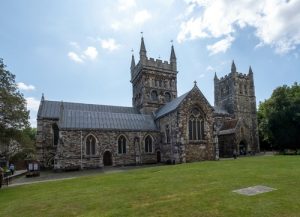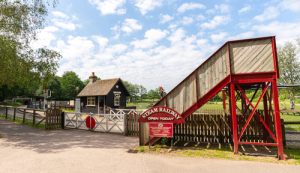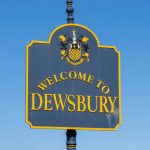
Wimborne Minster in Brief
Wimborne Minster is a market town and civil parish in East Dorset, southwest England. The town is situated at the confluence of the River Stour and River Allen, about 5 miles (8 km) north of Poole, and 10 miles (16 km) southeast of Blandford Forum. The town is usually referred to as just ‘Wimborne’, and similarly, the parish church, as just ‘the Minster’. The imposing parish church was founded in the early 8th century by the Saxons. In 2020, the town’s population was estimated at 8,276.
A Fleeting History
The Saxons
Wimborne Minster has its origins in the early 8th century which saw the area emerge as an important royal manor. Around AD 700, Ina, King of Wessex, founded the Bishopric of Sherborne, appointing St Aldhem as its first bishop. In 705, the King’s sister, St Cuthburga, founded a Benedictine Nunnery at Wimborne. Soon after, it’s thought a Benedictine monastery was also established at the site. Cuthburga, who died on 31 August 725, is buried within the confines of the Abbey, along with her sister Quinberga. In 871, Alfred the Great, also buried his brother Ethelred at Wimborne after a battle on Cranborne Chase. It was from then onwards that the local church was referred to as a Minster.
In 1013, Wimborne’s nunnery, thought to be already in decline, was destroyed by the Vikings. However, in 1043, Edward the Confessor helped to re-establish the town’s ecclesiastical credentials when he founded a college for secular canons around the same site. The conquering Normans refurbished the church and also retained the college. It went on to enjoy special status as a royal free chapel, independent of the Bishop’s rule, for many centuries. In the late 12th century, the future King John granted the Minster a charter during his tenure as the Duke of Gloucester. By 1200, a market and fair were being held at Wimborne on St. Cuthberga’s Day (August 31st).
Tudor Times
The Minster itself underwent further refurbishment and enlargement in the 13th, 14th, and 15th centuries. In 1496, Lady Margaret Beaufort, Countess of Richmond and the mother of Henry VII, founded a small chapel at the Minster. Her will made provision for a priest to be in permanent residence at the chapel. The priest was to be tasked with teaching grammar to all comers for free. The chapel formed the basis for the founding of Wimborne’s first school.
Henry VIII’s dissolution of the monasteries of 1536, saw Wimborne’s monastery incorporated into the Minster to stop it from being destroyed. Though the monastery was saved, Henry decided to confiscate much of the Minster’s wealth. However, in 1562, Queen Elizabeth I returned much of the property and former privileges back to the college. She also went on to reconfirm almost all of the provisions of Lady Margaret’s will. Though this was based on the condition that the school carried the name of Queen Elizabeth for perpetuity.
The 17th & 18th Centuries
Although Dorset was a hotbed of dissent during the English Civil War (1642 – 1651), Wimborne managed to come through it relatively unscathed. This was mainly due to the fact that the town took a relatively neutral stance during the war. It also had the protection of the local militia, the Clubmen, who also refused to take sides during the conflict. The beheading of Charles I in 1949, did see his family Coat of Arms erased from the wall of the Minster. However, the restoration of the monarchy by Charles II in 1660, saw the insignia quickly restored.
At the end of the 17th century, the population of the parish was still only about 750. However, during the 18th century that the town began to develop, albeit slowly, with the construction of a few townhouses. By 1772, a regular coach service from London to Dorset, which ran via Wimborne, had been established. The fare for the 14-hour journey was £1 4/- (£1.20), around £200 at today’s price.
The 19th Century
On 1 June 1847, Wimborne railway station opened on a site just north of the River Stour. It was built by the Southampton and Dorchester Railway, as a stop on the line that ran between the two destinations. However, major operators London and South Western Railway, took ownership of the line the following year.
In 1888, the railway station’s status was reduced when a more direct line from London to developing Bournemouth saw the town bypassed. However, it remained a busy local station for many years until the emergence of the motor car. The Beecham cuts to the rail network saw the station closed to passengers in 1964, and finally, to freight in 1977.
In 1881, the famed Dorset-born author Thomas Hardy moved to the town with his wife Emma. He resided in Avenue Road, penning the book ‘Two on a Tower’, during his 2-year stay. He reputedly based the plot of the romantic novel on the local tittle-tattle he heard when out and about in the town. In the book, Wimborne was substituted for the ‘little town of Warbourne’.
The Modern Era
Wimborne has a fairly mixed economy, where tourism plays its part. One of the biggest local employers is the aerospace company Cobham plc whose headquarters are in the town.
Wimborne’s Friday market is one of the largest open-air/covered markets in the south of England. There’s also a Farmers Market, selling local produce, held on the third Saturday of each month at the Market Square.
Wimborne’s Folk Festival is perhaps the biggest event on the town’s calendar. It’s normally held over the second weekend of June. Wimborne’s Food Festival, which promotes local produce takes place over 2 days in October. The annual Hairy Man Festival, an event celebrating the beard, takes place in September. The biennial Wimborne History Festival is a 2-day event that also takes place in September. The live-action festival celebrates the history of the town concentrating on the late Georgian period.
Wimborne Minster is twinned with Ochsenfurt in Bavaria, Germany, and Valognes in Normandy, France.
Getting to Wimborne!
London connects to Ferndown via the M3, M27, and A31. The town lies immediately adjacent to the A31 on the Ringwood to Winborne section. From the north, take the M4 and A34, linking with the A31 at Winchester. To the west, the A31 links to the A35, then onwards to East Dorset and Devon.
The nearest railway station to Ferndown is Branksome, around 7 miles (11 km) away. Branksome lies on the South West Main Line between Bournemouth and Parkstone, about 110 miles from London’s Waterloo.
Wimborne is only about 8 miles (13 km) from Bournemouth (BOH) International Airport at Hurn.
Notable Residents
- Timothy Berners Lee (born 1955) is a British computer scientist, who is widely recognised and best known for the invention of the World Wide Web. He was resident in Wimborne for around 3 years during the 1980s.
- Al Stewart (born 1945) is a Scottish-born singer-songwriter and folk-rock musician who grew up in Wimborne. Stewart is best known for his 1976 hit single “Year of the Cat”, taken from the platinum album of the same name.
- Thomas Hardy (1840 – 1928) is a world-renowned author who lived in the town’s Avenue Road. He resided at the house with his wife Emma between 1881 and 1883. Today, an English Heritage blue plaque marks the house which Hardy occupied.
- Isaac Gulliver (1745–1822) was one of Dorset’s most renowned bootleggers, and known as “King of the Dorset Smugglers”. His men were known as the “white-wigs” due to the fact that gang members used to whiten their hair. In later life, the wealthy Gulliver settled in Wimborne opting for a life of respectability. He became a churchwarden at the Minster and even managed to get himself knighted. He was interned at the Minster in 1822.
Did you know?
The Minster’s Chained Library opened in 1686, making it one of the oldest public libraries in Britain. A chained library refers to the fact that books are literally chained down. This was not an uncommon practice in Tudor times as books of that time were quite often highly valuable. It was local resident Roger Gillingham, who donated 90 books to the library in 1695, that insisted books be chained up and that the library be made free to the public.
Montague John Druitt, born in Wimborne on 15 August 1857, was once one of the chief suspects in the Jack the Ripper murders. He was pulled from the River Thames in December 1888, which was recorded as a suspected suicide. The still-unsolved Ripper murders ceased in November 1888. Druitt, a barrister, and notable cricketer, was buried in Wimborne Cemetery on 3 January 1889.
Things to do and see
Wimborne Minster

The impressive Wimborne Minster. Image credit: Wirestock Creators/Shutterstock.com
Wimborne Minister is the early 8th-century Saxon church from which the town takes its name. The church is most famed for housing the tomb of King Ethelred of Wessex, the elder brother of Alfred the Great. The church’s treasured possessions include a Saxon 1300 years old book, a book of sermons that once belonged to Catherine of Aragon, and a couple of Medieval clocks.
Wimborne Model Town & Gardens
Wimborne’s Model Town and Gardens is rated one of the best of its kind in the country. The attraction is a 1/10th scale model replica of the town as it was during the 1950s. The replica is so accurate it even includes a model of the model. The site also houses a working model railway, a collection of doll’s houses, a tearoom, and a crazy golf course. It opens from April to October, 10 am to 5 pm.
Kingston Lacy
Kingston Lacy is a grand 17th-century country mansion of Italian design. The house is set in formal gardens which form part of the 8,500 acres (2,125 ha) estate. There are a dozen different marked walks around the estate and regular guided tours run by the National Trust.
The English Oak Vineyard
The vineyard is set in the heart of rural Dorset around 6 miles southwest of Wimborne Minster. The informative vineyard tour is hosted by the owners themselves. Of course, the tour culminates in the obligatory wine tasting session of the vineyard’s award-winning wines.
Badbury Rings
The Badbury Rings is one of Dorset’s most impressive Iron Age hillforts. It lies just 4 miles southeast of Wimborne. Evidence suggests the 3-ringed hillfort was also occupied in the Bronze Age and Roman Era. The fort, set at 100m above sea level, offers some great views across the Dorset countryside.
Moors Valley Country Park
The Moors Valley Country Park consisting of some 750 acres of woodland and lowland heath is about 9 miles southwest of Wimborne. Activities and attractions in the park, include a Go Ape activity centre, miles and miles of cycling and walking trails, and a narrow-gauge steam train. You can also play golf or just choose to chill out by the lake. You’ll also find a restaurant, shops, and children’s play areas at the site.

Moors Valley Country Park Steam Railway. Image credit: Stefan Kadar/Shutterstock.com
Knoll Gardens
The 4-acre Knoll Gardens and nursery centre is most renowned for its ornamental award-winning grasses, which have won numerous top prizes at the prestigious Chelsea Flower Show. The gardens are located at Hampreston, about 3 miles east of Wimborne. The gardens are open from 10 am – 5 pm Tuesdays to Saturdays. There’s free parking and self-service refreshments on-site, with other eateries and a pub, also nearby.
Take a Hike!
There are loads of walks to be had around Wimborne. These range from the short 2-mile walk to Eye Bridge to the 64-mile hike along the Stour Valley Way.
Explore the River Stour
Dreamboats boat hire offers one of the most popular activities to do in Wimborne. You can hire a rowing boat for around £15/hour for a leisurely exploration of the River Stour. If rowing a boat is not for you, then you can also hire a kayak, a canoe, or an electric motorboat.
Sport in Wimborne
Wimborne Town FC
Formed in 1878, Wimborne Town FC is one of the oldest amateur football teams in the country. Nicknamed the Magpies they currently (2021) compete in the Southern League Premier Division South. They play their home games at New Cuthbury, which has an estimated capacity of 2,800.
Wimborne RFC
Wimborne RFC, formed in 1950, plays its home games at Leigh Park. The first XV play their rugby in the xxx league.
Wimborne CC
Wimborne CC’s first XI play their cricket in the Dorset Premier League. They play their home games at ‘The Leaze’, which is also currently the home of Dorset County Cricket Club.
Where to Stay?
Wimborne and the surrounding area offer a decent range of accommodation in terms of type and price. However, it mostly consists of bed & breakfasts, guesthouses, inns, and holiday lets. However, if you’re looking for more luxury, the likes of Poole and Bournemouth, at 6-7 miles away, offer a good range of top-end hotels. At the budget end of the scale, camping and caravanning are also possible.
Thinking of moving to Wimborne?
Are you thinking of moving to Wimborne anytime in the near future? Properties in Wimborne have sold for an overall average price of £418,000 in the last year (October 2021). The majority of properties sold in Wimborne during the last year were detached properties, which sold for an average price of £494,000. Flats sold for an average of £240,000, while semi-detached properties fetched around £357,000. Overall, property prices in Wimborne were 6% up on the previous year.
Looking for a Staycation?
Are you thinking of holidaying in the UK anytime in the near future? If so, why not check out some of our other travel guides for some staycation ideas? I think you’ll be surprised at the variety of great things to do in the UK’s fairly green and mostly pleasant land.
Header image credit: David Jeffrey Morgan/Shutterstock.com
Why not take our Wimborne quiz?
Quiz Maker – powered by Riddle


